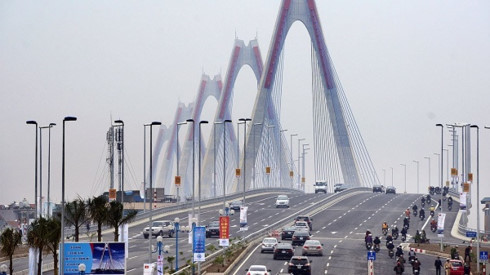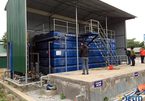 |
Nhat Tan, the first cable-stayed bridge is a significant construction in Hanoi and the Northern region.
Vietnam’s Northern key economic zone has seen its economic grow at a higher speed than other regions in the country, the report of the Ministry of Investment and Planning showed.
Even though lagging behind the Southern key economic zone in some indicators, the one in the North has outpaced the growth rate of the three other national key economic zones, the report on results of implementing the socio-economic development plans in the 2016-2018 period shows.
In fact, its Gross Regional Domestic Product (GRDP) growth rate reached 9.08% from 2016 to 2018, exceeding the target of 9% for the whole period of 2016-2020, the government portal reported.
However, the region’s GRDP accounted for 31.73% that of the whole country and ranked second among the four key economic zones, behind the Southern key economic zone with 45.42%. Hanoi took the lead in the region when contributing 16.96% to the country’s GDP.
GRDP per capita in the region grew from US$4,164 in 2016 to US$4,813 in 2018, 1.68 times higher than the national average. By 2020, the region will strive to beat the target of US$5,500.
Industry sector expands impressively
The economic structure has shifted positively in accordance with the transformation of growth model. The agricultural, forestry and fishery sectors account for the smallest proportion while the service sector makes up the biggest proportion to GRDP compared to other zones.
In some localities, the service sector makes up high percentage in GRDP such as Hanoi with 64%, the highest rate in the country and Hai Phong with 44.05%.
By 2018, the agriculture made up only 3.71% of the region’s economic structure.
Industrial and construction sector is the driver for accelerating growth which are attracting a number of large scale and significant projects.
In the 2016-2018 period, the sector contributed nearly 40% to national GDP with electricity, electronics manufacturing, automobile assembling, and shipbuilding being the major contributors.
The Northern zone has 27 logistics centers accounting for 55% of the total nationwide with 14 in Bac Ninh, 11 in Hanoi and two in Hai Phong.
In the same period, the region’s export grew 25.6% on average and made up 32% of the country’s total.
In the 2016-2020 period, the export turnover increased by 57% from US$49.6 billion in 2016 to US$78.1 billion in 2018, much higher than the national average rate of 38%. Meanwhile the import value of the region rose by 44.9% from US$61.8 billion in 2016 to US$85.9 billion in 2018, higher than the national average rate of 35.5%.
Numbers talk
Taking into account the agriculture reconstructing, the Northern region had 936 out of 1,217 villages that meet the standards of new style rural areas, accounting for 76.91%, the highest rate among the four key economic zones and much higher than the national average rate of 46.48%.
The total state budget revenue collection in the period of 2016-2018 exceeded the estimations.
The business and investment climate is continuously improved with the number of enterprises increasing from 146,377 in 2016 to 204,310 in 2018, making up 28.6% national operational businesses.
The region ranked second nationwide in foreign direct investment (FDI) attraction in the same period with total registered investment capital of US$32.1 billion. In 2018, Hanoi drew US$7.5 billion of FDI and took the lead for the first time in terms of newly registered capital.
Total development capital reached VND1,593 trillion (US$68 billion), making up 29.76% of the country’s total investment.
Limitations in technology based development
However, there are still shortcomings and difficulties in the regional socio-economic development. In particular, the growth pace of the service sector is still leaving much to be desired.
All seven provinces and cities in the region set out the targets of developing electronics manufacturing and hardware industries but only some big economic hubs including Hanoi, Hai Phong, and Bac Ninh are able to attract foreign businesses such as Samsung, LG, Microsoft and Canon, among others.
The total trade turnover of the Northern economic zone in the period of 2016-2018 reached US$426.4 billion. However, the region failed to contribute to the surplus of the national trade balance. While Vietnam enjoyed a trade surplus of US$10.69 billion in the period 2016-2018, the Northern economic zone suffered a trade deficit of US$40.781 billion.
Besides, the export growth rate is still unsteady, down from 31.2% in 2016-2017 to 20% in 2017-2018.
Provincial competitive index (PCI) and Provincial Governance and Public Administration Performance Index (PAPI) in some areas remain at the average-low level group of provinces.
Although the region ranks second nationwide in business formations, the newly created businesses are mainly small and medium-sized. FDI projects are mainly labor intensive.
Additionally, the region has to tackle some problems relating to budget revenue, population, immigration among others. Especially, socio-economic development has not responded to the requirements of being environmentally friendly or saving natural resources. Hanoitimes

Vietnam's industrial zone projects face obstacles
Because of local agencies’ tardiness in setting up a land rental framework, the HCMC Hi-tech Park (SHTP) in the first four months of the year granted licenses to only two projects with registered capital of $5 million.

Made-in-Vietnam waste water treatment can be used in industrial zones
ETM-hika system can separate raw and fine garbage to remove large-size waste and impurities, which, combined with the application of physicochemical technology, can eliminate harmful substances and protect the environment.

Real estate market focuses on industrial zones
The reports released by securities companies so far this year all show the bright prospects of the industrial real estate market segment.
 In 2018, Hanoi drew US$7.5 billion of FDI and took the lead for the first time in terms of newly registered capital.
In 2018, Hanoi drew US$7.5 billion of FDI and took the lead for the first time in terms of newly registered capital.